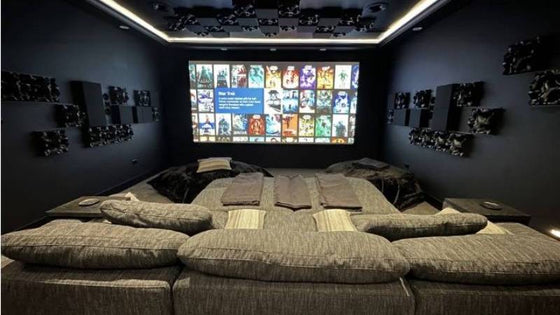Creating a system you love shouldn't be difficult. The Acoustic Frontiers blog is here to help.

In this blog article we look at the dispersion requirements for ceiling speakers in a Dolby Atmos system. We consider the example of a system with 4 ceiling speakers and two seating rows and show how dispersion requirements change for:
Dispersion is another word for coverage – the question we are asking is “does each member of the audience hear the same sound?”.
The sound emitted by a speaker can be thought of as a cone that expands in area as distance from the speaker increases. Simplistically speaking if listeners are within the coverage “cone” then they will hear the same thing and if they are outside it they will hear something different. It’s obviously not as simple as this, but it is true that high frequencies can fall off significantly even at small off axis angles. For example if a speaker only covers out to 30 degrees off axis then someone at 60 degrees off axis will hear something very different from someone on axis.
For a more detailed explanation of speaker coverage and the Acoustic Frontiers coverage targets please read our article on dispersion specifications and off axis response plots.
In our imaginary home theater we have two rows of ceiling speakers (a 7.1.4 system) and two seating rows. The first ceiling speaker is at an angle of 55 degrees from the perspective of the first row, and the second ceiling speaker at an angle of 115 degrees.
If you are an eagle-eyed reader then you might notice that these angles are slighly outside the official specifications. As explained in our article 10 speaker layout tips for Dolby Atmos, DTS.X and Auro, we think the specifications should be adapted for multi-row theaters, in particular to provide clear line-of-sight to all surround speakers. The impact of this are changes to the angles for the ceiling speakers, since the rear surrounds are higher than ear level.
The two drawings below show the coverage / dispersion requirements for speakers pointed straight down vs. angled at a point between the two seating rows.
With the speakers pointed straight the front Atmos ceiling speaker must have consistent coverage out to ~70 degrees off axis! If you understand typical speaker dispersion profiles then you’ll know that very few speakers have such wide coverage.

Required coverage / dispersion, speakers pointing straight down. 9 foot 6 inch ceiling.

Required coverage / dispersion, speakers aimed at point between two seating rows. 9 foot 6 inch ceiling.
Angling the speakers significantly reduces the dispersion requirements, especially for the first ceiling speaker row.
Note that these drawings only consider coverage in one dimension; in reality you also need to consider coverage across the width of the seating area.
The dispersion requirements for the 9’6″ ceiling were shown above. Let’s now look at those for 8’6″ and 7’6″ ceilings.
First let’s see what losing a foot in room height means for coverage in the case of the speakers pointing straight down.

Speaker coverage, speakers pointing straight down. 8 foot 6 inch ceiling.

With 7’6″ ceilings and speakers pointed straight down we need almost ~80 degrees of consistent off axis coverage. Even the back row of ceiling speakers needs ~65 degrees.
Now let’s see what happens with angled speakers and lower ceilings.


7 foot 6″ ceilings.
These examples clearly show that angling speakers significantly reduces the coverage requirements. The coverage of the second ceiling row will become the limiting factor in a two row home theater.
We can draw the following conclusions:
All this goes to show that a very critical part of any home theater design is ensuring the speakers selected can provide consistent coverage of the seating area. You really can’t select a set of speakers unless you know what the coverage requirements are, and you also have to know what the speakers are capable of as many manufacturers provide no data or specifications.
Of course we have tried to keep things simple in this article but there is more complexity to consider with a Dolby Atmos speaker layout:
Learn how early home theater design, layout, and acoustic treatment improve performance in new home construction.
This media room was intentionally designed to feel like part of the home—not a separate, tech-heavy space. Through careful acoustic planning, equipment integration, and final calibration, we achieved a room that is both beautiful to live in and immersive to experience.
"No other subwoofer system I’ve owned even comes close to what this room delivers. Reaching out to Acoustic Frontiers was one of the best decisions I’ve made—I highly recommend working with them if you want to get the most out of your theater."

Nyal Mellor, Founder, Acoustic Frontiers



Nyal Mellor
Author